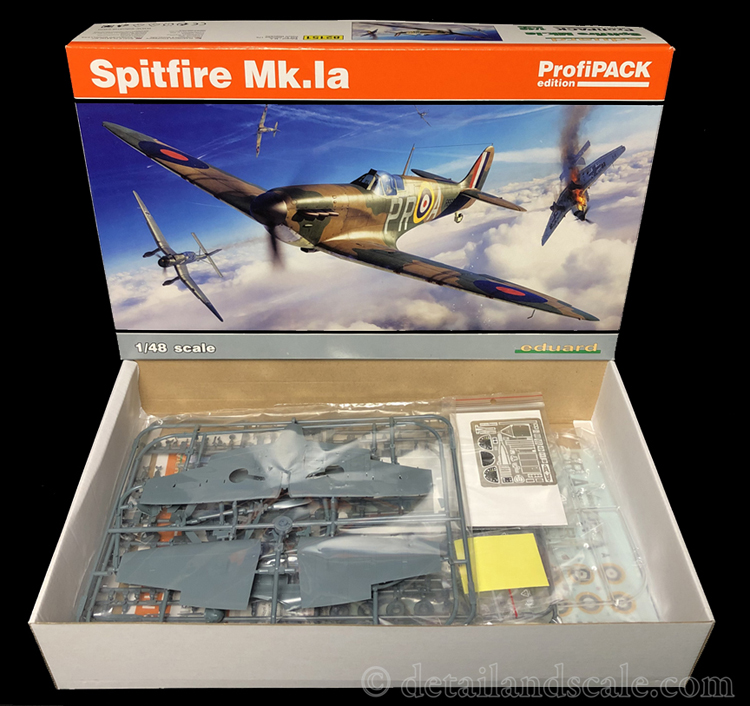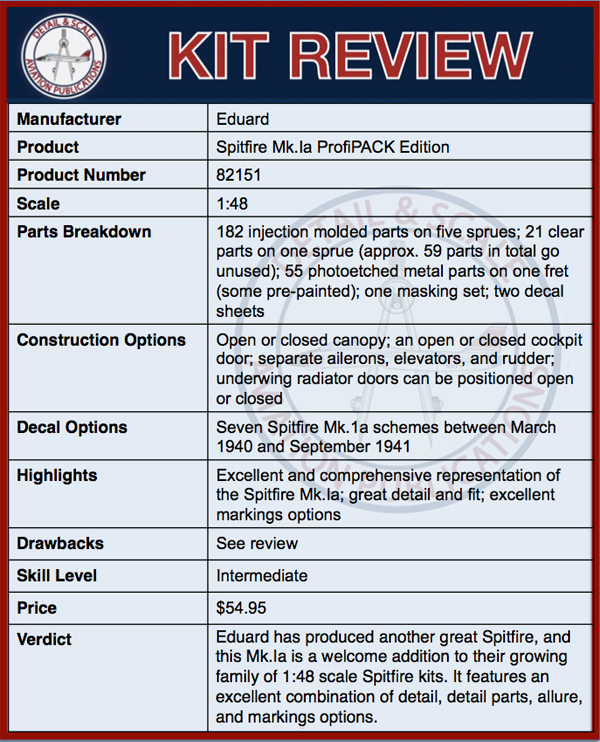Eduard # 82151 Spitfire Mk.Ia — 1:48 Scale


The legendary Supermarine Spitfire helped turn the tide of the Battle of Britain and shaped the outcome of the rest of World War II, especially in Europe. In August 2020, Eduard premiered their series of 1:48 scale early Spitfires in “Spitfire Story: The Few” in August 2020 (and see our review HERE). Since then, the early Spitfire kits have been rolling out of Eduard’s warehouses at a steady pace. Here, let’s sit down with their Spitfire Mk.Ia ProfiPACK Edition kit.

The origins of the Spitfire date back to 1931 when Great Britain’s Air Ministry released a specification calling for a modern fighter capable of an airspeed of 250 mph. In response, the famous R. J. Mitchell developed the Type 224, an open-cockpit monoplane with gull-wings and large, fixed, undercarriage. The Gloster Gladiator biplane won that contract. Undeterred, Mitchell developed the improved Type 300 for another new fighter contract in 1935. It first flew in prototype form in 1936. This narrow-fuselage, elliptical wing design soon became known as the Spitfire, and later that year, the Air Ministry placed an order for 310 aircraft.
The first production Spitfire Mk.I took flight in 1938. The Spitfire Mk.I was quite agile. It could reach a maximum speed of 362 mph and climb at nearly 2,500 feet per minute until reaching its service ceiling of 31,000 feet. It was powered by the 1,030 hp Merlin Mk.II engine, until the Merlin Mk.III was introduced with the 175th production airframe. The first 77 Mk.Is had a two-bladed wooden prop that was superseded by a larger three-bladed propeller that notably improved take-off performance, maximum speed, and ceiling. A blown canopy replaced the original flat canopy in 1939 to improve visibility. Beyond these, many dozens of additional small and incremental changes (“fine-tuning”) were implemented over the course of Mk.I production and service lifetime. A total of 1,567 Mk.Is were produced. The Mk.Ia was the version armed with eight Browning machine guns.
The Spitfire Mk.I achieved operational status with 19 Squadron at RAF Duxford on 4 August 1938. It was a front-line combat aircraft for 18 months before being replaced by the much-improved Spitfire Mk.V. Yet, in that time, Spitfire Mk.Is contributed invaluably to the war. Its first encounter with the Luftwaffe was at Dunkirk and demonstrated that the feared Bf 109 had more than met its match. During the Battle of Britain, Spitfire Mk.Is famously defended Great Britain alongside the Hawker Hurricane and ultimately repelled the Nazi onslaught above England.

Eduard’s 1:48 scale Spitfire Mk.Ia ProfiPACK edition kit contains 182 injection-molded parts on five sprues and 21 clear parts on one sprue (and about 59 of which are not used). Additionally, 55 photoetched metal parts are included on one fret (nine are pre-painted). There is also a pre-cut, self-adhesive masking set and two decal sheets. The full color instruction booklet organizes the build over 15 pages. Markings for seven airplanes are provided:
- Spitfire Mk.Ia R6709, flown by P/O Colin Falkland Gray, RNZAF, No. 54 Squadron, RAF Hornchurch, United Kingdom, March 1940
- Spitfire Mk.Ia N3250, flown by P/O Allan R. Wright, No. 92 Squadron, RAF Croydon, United Kingdom, late May/early June 1940
- Spitfire Mk.Ia R6690, flown by P/O John C. Dundas, No. 609 Squadron, RAF Middle Wallop/RAF Warmwell, United Kingdom, August 13th, 1940
- Spitfire Mk.Ia R6835, flown by F/O Brian J. Carbury, No. 603 Squadron, RAF Hornchurch, United Kingdom, late August 1940
- Spitfire Mk.Ia P9386, flown by S/Ldr Brian J. Lane, No. 19 Squadron, RAF Fowlmere, United Kingdom, September 1940
- Spitfire Mk.Ia X4253, flown by P/O Wilfrid G. Duncan Smith, No. 611 Squadron, RAF Hornchurch, United Kingdom, February 1941
- Spitfire Mk.Ia X4828, flown by F/Lt Wojciech Kolaczkowski, No. 303 Squadron, RAF Speke, United Kingdom, September 1941
Strengths: Eduard’s Spitfire Mk.Is build upon a legacy of their later-model Spitfire kits, which are arguably the best of their kind in 1:48 scale. Eduard’s very fine interpretation of the Spitfire Mk.I also holds its own against the Tamiya kit on many levels.
What is distinctive in this issue of the Eduard Spitfire Mk.Ia? In terms of the plastic, you will find all that is needed to represent the eight-machine gun configuration and the three-bladed Rotol constant-speed propeller. As with the previous releases of this kit, the fuselage and wings shine with an exceptional quality of surface details – just perfection. There’s a combination of beautiful recessed and raised details (raised rivets and fasteners where they should be) that should be very nice to work with. Fabric covered control surfaces display a slightly perceptible roughened texture. I test fit the major assemblies, and at that early stage, fit appears to be airtight and just about perfect.
The parts breakdown is quite conventional (left and right fuselage halves, upper and lower wing halves. There is, however, a nice internal wing spar that will help solidify the wings. Construction options include an open or closed canopy, an open or closed cockpit door, and separate ailerons, elevators, and rudder. The control surfaces are engineered to go straight-in, and if the builder wishes to position them in anything other than the neutral position, removal and clean-up of the mounting tabs will be necessary. Underwing radiator doors can be positioned open or closed. The kit also captures the myriad of small differences among the Mk.Ia variant, such as with the optional parts for the original plain windscreen and later armored windscreen, the differing antenna configurations, and different wheel hub designs. Other small details, such as gunsights and few ultra-subtle differences in the cockpit configurations are faithfully reproduced and presented as construction options.
The kit cockpit will remind a lot of people of the complexity and detail seen in Eduard’s other 1:48 scale Spitfires as they share a basic design lineage. There is a rather high level of detail and accuracy for an injection molded kit here with the seat, cockpit frame, and sidewall details, but what really makes this cockpit excellent are the beautifully made pre-painted, multi-layer photoetched instrument panel, shoulder harnesses and lap belts, and other detail parts. The exhaust stacks also deserve a mention. Most injection molded exhaust stacks are flat-ended, but here, they are nicely hollowed out. The masking set for the clear parts and wheel hubs is a very nice, time-saving feature that will ensure precise masking where it is most needed.
Spitfire Mk.I paint schemes were mostly all the same – not a lot of variety. Yet these markings options cover a range of interesting variations within the Mk.Ia repertoire from before, during, and after the Battle of Britain. It’s an excellent set of markings options, indeed. The decals are wet transfer markings as well.
Weaknesses: I cannot offer any substantive critiques of this kit. Close eyeballing will find a few very minor sink marks on a few parts, but they are small and not particularly noticeable.

Eduard continues to do a great job with their Spitfire Mk.Ia ProfiPACK edition. For those interested in even more detail, Eduard has various detail sets in their Brassin, LööK, and Space product lines. We look forward to the Spitfires that will continue to be released by Eduard in the near future as their family of Spitfire kits continues to expand.
Sincere thanks are owed to Eduard for the review sample. You can visit them on the web at http://www.eduard.com and on Facebook at https://www.facebook.com/EduardCompany
Haagen Klaus
Scale Modeling News & Reviews Editor
Detail & Scale


